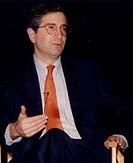In an era of constant technological innovation, every mature organization must reinvent itself to stay competitive. Last week,
Founded in 1963 as a single-system cable operator, Comcast experienced phenomenal growth through the 1980s and 1990s aided by new technology, a series of well-timed mergers and acquisitions, and the addition of Comcast SportsNet, cable channel CN8 and the Philadelphia Flyers and 76ers sports teams. In earnings figures released Monday, the company listed 7 million cable TV customers and close to 142,000 high-speed subscribers in 14 markets. Revenues for 1999 were $6.2 billion, up from $5.1 billion in 1998; operating cash flow in the fourth quarter rose to $533.7 million, up from $421.3 million a year earlier.
In their presentation at Wharton, Roberts and Burke discussed several forces leading to Comcast’s success, including the purchase of shopping channel QVC – the company’s biggest programming asset – and serendipity.
QVC, of which Comcast is majority owner and manager, is the largest electronic retailer in the country that combines both television and shopping. It is the second most profitable television network, posting growth rates of 15-20%. QVC, for example, has sold $25 million worth of Pentium PC’s in one day and three million Pokemons in one hour. Last year iQVC did $100 million in sales out of its inventory alone.
Serendipity entered the picture five years ago when, in answer to satellite TV, cable companies began to rebuild their old lines to carry more data As a result, cable companies in this new age of broadband own the best fat pipes available. This wasn’t a planned coup, says Roberts, but rather a competitive response for one threat that positioned Comcast and other cable companies for the future.
Comcast, according to Roberts, plans to distribute more channels and more products. The company is making multiple bets and acquisitions while looking for synergies between commerce, content and distribution that allows it to develop scale and favorable geographic clustering of customers.
The company’s main challenge is to focus its resources on differentiating its high speed data, video on demand and other services enabled by broadband when the company’s analog past is still a large part of the corporate pie. Comcast is reportedly preparing to spend $1.2 billion to upgrade its cable TV network to provide more channels, interactive television, telephone service and high-speed Internet service.
Both Roberts and Burke were asked how they intend to get Comcast and its employees ready for the future. Part of the answer lies in prioritizing. The company spells out the factors for success in its company credo. It redid the logo – creating a new face for a new time. Getting out new products excites the marketplace and the employees, who will rise to the increased level of competitiveness, Roberts said. The company is working on upgrading customer service and has started Comcast University for all of their front line employees. "Ten years from now, Comcast will be a different company," said Burke. "This will draw more competition and more uncertainty for what the future will hold. But Comcast must be prepared and that includes getting its people excited today."
In a discussion of Internet networking and the intelligent wireless house, Roberts stated that the clear winner will be companies who bring the bits into and out of the home and make it easy for consumers to use. There will, however, be multiple roads into the home. Both Burke and Roberts admitted to not knowing exactly what will happen. "There are so many companies creating content and applications that need broadband to enable their business. It’s like the creation of the PC, which became more than anyone would have guessed at its birth. Broadband does not have to know exactly what it will become. Applications that providers haven’t thought of will arise when customers have widespread access and begin to let us know what they want in addition to what we have to offer," said Roberts.
To help drive application development, Comcast started Comcast Interactive Capital which invests in B2B and B2C companies that are reshaping how firms do business. Comcast generates $1.4 billion in cash from its television position (including QVC) and will use that to fund strategic initiatives.
As for the bundling strategy employed by AT&T and AOL, Roberts and Burke discussed both companies’ competitive positions and suggested that bundling is essential for them as a result of their legacy operations and the nature of their businesses. "Bundling for AT&T and AOL has huge strategic implications," said Roberts. "But consumers aren’t looking for bundling specifically – they are looking for the simplicity and discounting it can provide. As such, it’s a little overplayed."
What will the broadband roadmap look like in the future? There are two different opinions in the industry. In order to avoid regulation, AT&T wants broadband to be an open road where anyone who plays by the rules can travel. The other end of the spectrum advocates a gatekeeper system where everyone using the road must pay tolls or equity. This approach, Roberts noted, is not necessarily the right business model because it decreases competition, which is not what consumers value. "The real solution," said Roberts, "lies somewhere in the middle. The point is that you have to get ahead and stay ahead because connected people are not likely to switch providers."



